This was published 5 years ago
San Sebastian, Barcelona, Madrid: Why Spain is the perfect destination to indulge in food and wine, art and culture
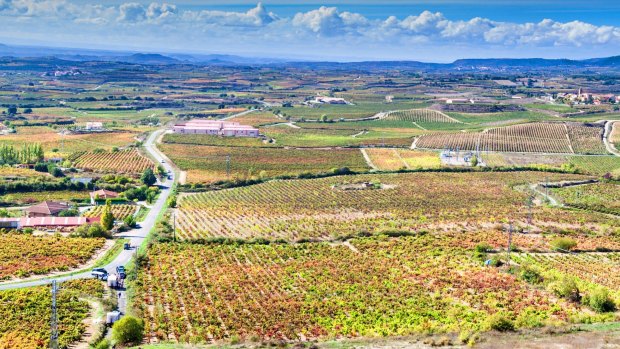
Vineyards near Laguardia village in northern Spain.Credit: Shutterstock
This is the good life. I've just rolled out of a Michelin-star cooking class in sun-drenched San Sebastian, where I created and devoured delicate sous vide salmon and seared seasonal vegetables, accompanied by lashings of cava.
I'm now standing at the western end of La Concha Bay, a perfect arc of sugar-soft sand framed by rugged hills, admiring Basque sculptor Eduardo Chillida's iron Wind Comb sculptures, reaching out from the rocks towards the sea. Soon, I will wander back through the warm, crisp spring air to my luxurious Belle Epoque Hotel Maria Cristina, to complete the Spanish holy trinity of architecture, art and alimentation.
Back home, an afternoon like this would feel uncomfortably overindulgent. But here in Spain, where locals need no excuse to relish the finer things in life, it feels just right.
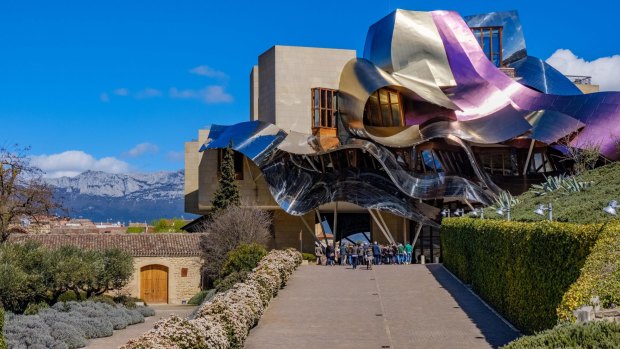
The Frank Gehry-designedMarques de Riscal winery hotel.Credit: Shutterstock
This journey into the good life, led by the doyennes of luxury travel, Abercrombie & Kent, began three days earlier in Barcelona. The Catalonian capital's enduring reputation for good living and great art made it the perfect launch pad for this food and art-focused Spanish sojourn.
My travel companions and I spent two glorious days admiring Antoni Gaudi's architectural masterpieces, dipping in and out of tapas joints and zooming through the city by night in classic sidecars. We drove an hour south of the city to the Penedes wine region, where we cycled through the vines with a local winemaker, visited vineyards including Spain's oldest cava house Codorniu, and sampled mouth-watering Catalan cuisine – briny white anchovies, salt cod croquettes and pared-back paella.
Those first few days of extravagance, however wonderful, had made me a little uneasy. At the beginning of any trip we're often busy fighting our home habits – the urge to feel constantly productive, to move at our usual light speed, to maintain the relentless hustle. It took me three full days to stop feeling guilty. But by the time I finish my San Sebastian cooking class, I'm ready to do as the Spanish do and simply enjoy life.
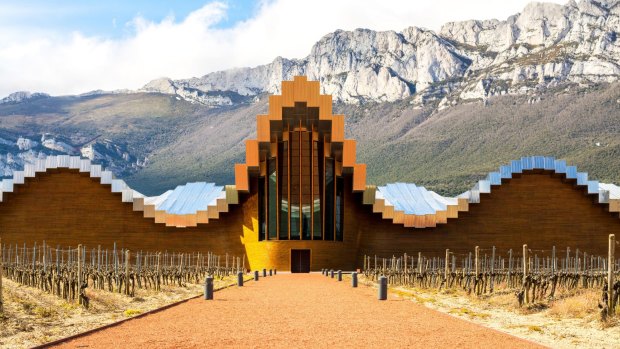
The futuristic winery Ysios in La Guardia.Credit: Shutterstock
Which is perfect timing, really, because the following morning we head out to La Rioja, Spain's most renowned wine region. The jagged Cantabria mountains rise around vineyards snaking across the wheat-coloured earth, while walled medieval towns crown the hilltops like something from a fairytale.
La Rioja is an emerging capital of avant-garde winery architecture, meaning every so often some futuristic structure rises out of the landscape like a spaceship, a fantastic counterpoint to the bucolic scene. There's Tonodonia winery's Zaha Hadid-designed white, triangular shop and tasting room; the Santiago Calatrava-designed Ysios winery, its wave-like roof echoing the undulations of the surrounding mountains; and Frank Gehry's Marques de Riscal winery hotel, which looks as though it has been wrapped in a giant purple ribbon.
There are tastings along the way, of course. But our Rioja highlight comes in the form of a visit to the 10th century medieval town of Laguardia. Encircled by rough stone walls that nod to its history as a military fort, it is the jewel of the region, and a city as plump with history as it is with food and wine.
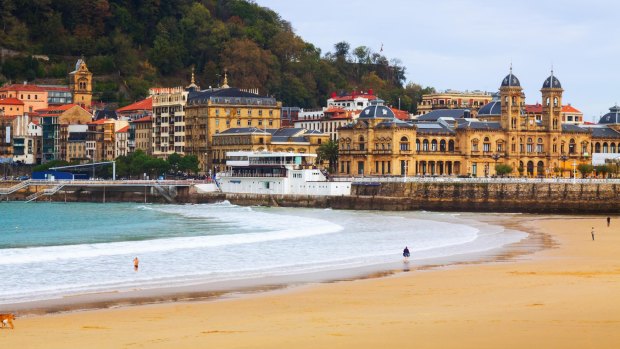
La Concha beach in San Sebastian. Credit: Shutterstock
The narrow, cobbled laneways, where cars are forbidden, are lined with pintxos (the Basque take on tapas) bars, cafes, bakeries and wine bars. Some of these are housed in the 234 underground cellars that were excavated by hand in the 10th century, and were originally used to keep the townspeople safe during battles.
In the town's elegant main square we're met by Javier Ruiz, a fast-talking, effervescent local guide who escorts us through a tangle of scrubbed cobbled alleys echoing with distant civilisations, to his home for lunch. It's a simple exaltation of local produce, and a study in the art of slow dining. Crisp white Rioja Viura with local bread that we rip off in chunks from the loaf; potato and paprika soup with chorizo made by his grandmother; thick white asparagus spears sprinkled with red wine salt and aged Manchego.
As we eat, nutty olive oil dripping down our chins, Ruiz tells us about daily life in this historic town. About the parties he has with friends almost every night, and the rich community spirit that makes it feel as though the entire town is one family. Many other medieval towns around the Spanish countryside are dying out as the younger generations move to urban centres, he says, but Laguardia is still a living, breathing town and therefore a rare gem. It feels like one, too, especially when we realise five hours have been magicked away in this gracious man's home.
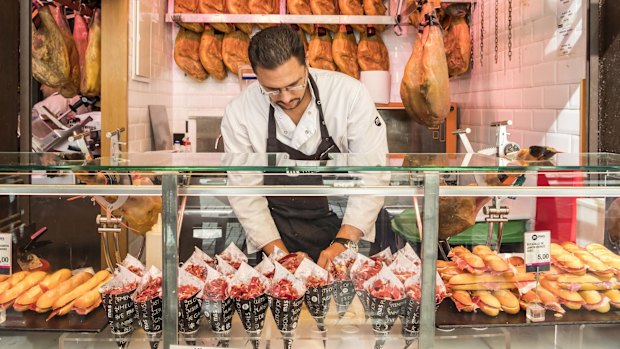
A stand selling Iberico ham in San Miguel Market.Credit: Shutterstock
By the time we arrive in Madrid three days later – via two days in Bilbao exploring Frank Gehry's iconic Guggenheim museum, and discovering all the ways in which it has transformed this erstwhile industrial city over the past decade – we have dropped back five gears. We're drinking wine before lunch. We're feeling OK about eating dinner hours later than we would at home in Australia. We're caring less about covering off the city's phenomenal cultural tick-list (although a turn about the Prado and Thyssen museums has to happen), in favour of living like real Madrilenos.
We get lost in the tightly packed maze of blossom tree-lined alleyways spidering out from the expansive 17th-century Plaza Mayor, then sit up at a bar in the Mercado de San Miguel, one of Madrid's oldest and most lively food markets, eating pintxos and drinking crisp cava.
Madrid is a famously fun-loving city where going out to drink, dance and debauch is as necessary for the locals as food and sleep. So even though I feel a flu coming on during dinner on our second night in the city, I decide to ignore it and head out to a late-night flamenco show held in a low-ceilinged venue called Casa Patas in the historic Lavapies neighbourhood. Sitting in the packed, dimly-lit club nursing a glass of sangria, I am mesmerised by the dancer's intricate, sweat-slicked movements, by the hypnotic, savage rhythm of their clapping hands and percussive footwork. My aching bones and throbbing head are quickly forgotten.
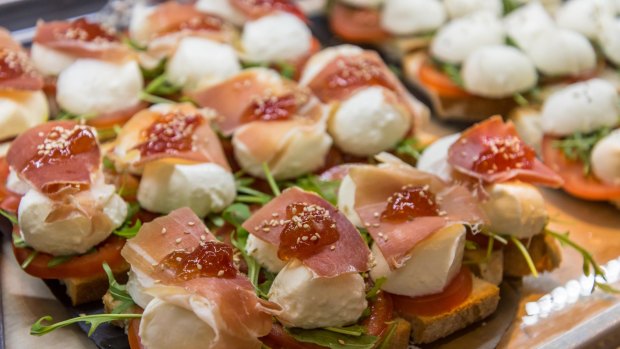
Parma ham and mozzarella pintxos at Mercado de San Miguel.Credit: Shutterstock
Back home, I know I would have felt guilty for ignoring my body like this. But here in Madrid, as I walk out into the fresh night air where whole families are still out enjoying life, it feels just right.
TRIP NOTES
Nina Karnikowski travelled as a guest of Abercrombie & Kent and Cathay Pacific.
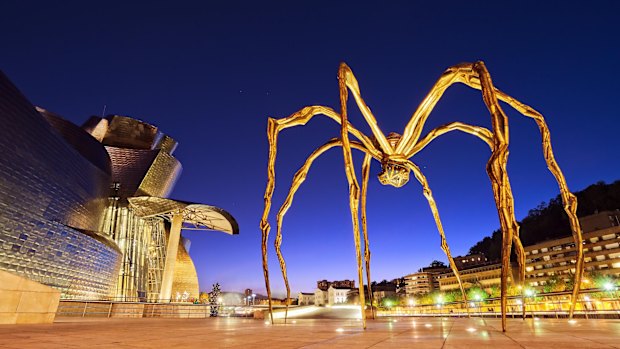
Louise Bourgeois's The Spider, Guggenheim Museum, Bilbao.
MORE
FLY
Cathay Pacific flies from Sydney, Melbourne, Brisbane, Perth, Adelaide and Cairns to Barcelona via Hong Kong. See cathaypacific.com.au.
TOUR
Abercrombie & Kent specialises in private and small-group journeys to Spain. An eight-day private journey through the north of Spain, including two nights at Hotel El Palace Barcelona, two nights at Hotel Maria Cristina San Sebastian, two nights at Gran Hotel Domine Bilbao and two nights at Hotel Orfila Madrid, costs from $14,855 a person, twin share. See abercrombiekent.com.au
FIVE MORE GREAT FOOD AND WINE EXPERIENCES
1. BILBAO'S GUGGENHEIM MUSEUM
Even if you just make it to the outside of Frank Gehry's 1997 masterpiece, where you'll find Jeff Koons' giant puppy covered in 40,000 fresh flowers, this iconic museum will be well worth a visit. See guggenheim.org
2. BIBO MADRID
Fancy tapas, fantastic cocktails and fresh seafood by acclaimed Andalusian chef Dani Garcia, in a fun space flaunting 7000 light bulbs and a hot air balloon as the centrepiece, it's no wonder Bibo is one of Madrid's hottest dining spots. Don't miss the cherry gazpacho. See grupodanigarcia.com
3. CHILLIDA-LEKU SCULPTURE PARK
Pack a picnic to enjoy the peaceful gardens, dotted with 40 of Eduardo Chillida's huge granite and steel minimalist sculptures, just five kilometres from San Sebastian. Visit Chillida's stunning stone farmhouse while you're there, filled with more of his artworks. See museochillidaleku.com
4. LA BOQUERIA MARKET, BARCELONA
Dating back to the 1200s, Barcelona's Boqueria market is worth a visit as much for its modernista-influenced design, as for the sights, smells and colours of the food market inside, where many of the city's top restaurateurs source their produce. See boqueria.barcelona
5.PINTXOS TOUR, SAN SEBASTIAN
San Sebastian's cobbled streets are crammed with drool-worthy pintxos bars, but the choice can be overwhelming for the first-time visitor. A guided tour of the best of them, with local outfit Mimo Food, will definitely help, and make for a really fun night out. See sansebastian.mimofood.com
Sign up for the Traveller Deals newsletter
Get exclusive travel deals delivered straight to your inbox. Sign up now.